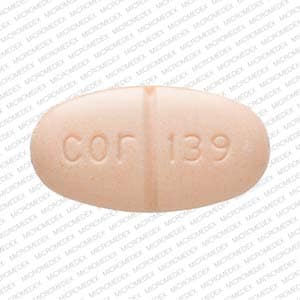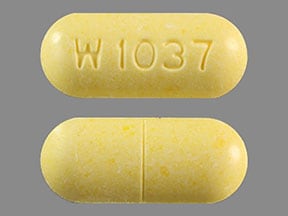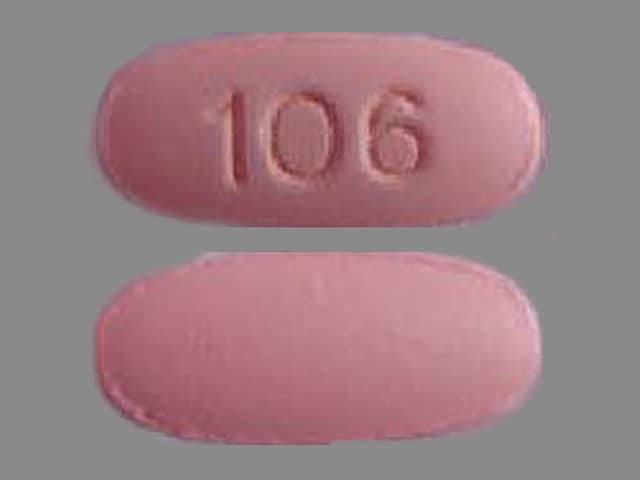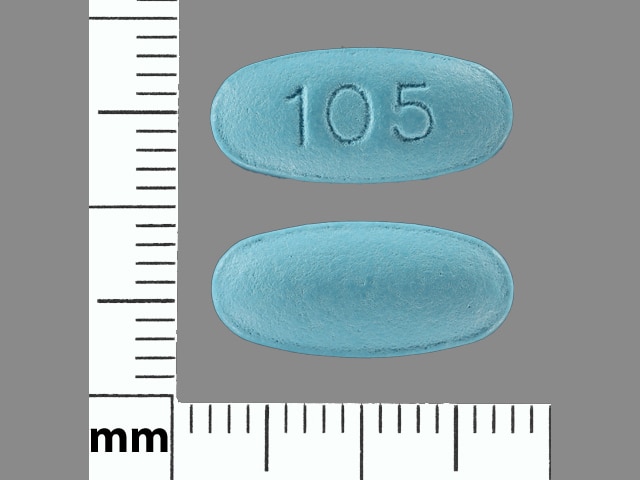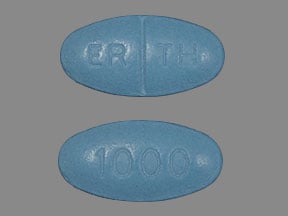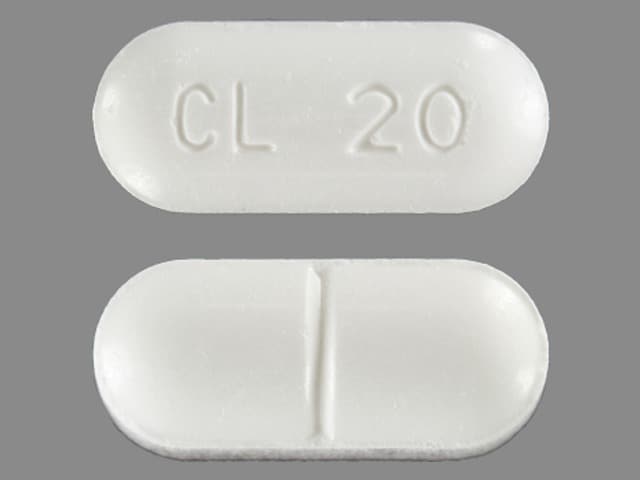Dosage Forms
Excipient information presented when available (limited, particularly for generics); consult specific product labeling. [DSC] = Discontinued product
Tablet, Oral, as hippurate:
Hiprex: 1 g [scored; contains saccharin sodium, tartrazine (fd&c yellow #5)]
Hiprex: 1 g [DSC] [contains tartrazine (fd&c yellow #5)]
Generic: 1 g
Tablet, Oral, as mandelate:
Generic: 0.5 g, 1 g
Pharmacology
Mechanism of Action
Methenamine is hydrolyzed to formaldehyde and ammonia in acidic urine; formaldehyde has nonspecific bactericidal action. Other components, hippuric acid or mandelic acid, aid in maintaining urine acidity and may aid in suppressing bacteria.
Pharmacokinetics/Pharmacodynamics
Absorption
Readily from the GI tract; 10% to 30% of the drug will be hydrolyzed by gastric juices unless it is protected by an enteric coating
Distribution
Vd: 0.6 L/kg (Allgén 1979)
Metabolism
Hydrolyzed to formaldehyde and ammonia in the urine; ~10% to 25% in the liver
Excretion
Urine (~70% to 90% as unchanged drug) within 24 hours
Time to Peak
1 to 2 hours (Allgén 1979)
Half-Life Elimination
~4 hours (Allgén 1979)
Use: Labeled Indications
Urinary tract infection, prophylaxis/suppression: Prophylaxis or suppression of recurrent urinary tract infections when long-term therapy is indicated and infection has been eradicated by appropriate antimicrobial treatment
Contraindications
Hypersensitivity to methenamine or any component of the formulation; severe dehydration; renal impairment; severe hepatic impairment; concurrent treatment with sulfonamides
Dosage and Administration
Dosing: Adult
Urinary tract infection, prophylaxis/suppression: Oral:
Hippurate: 1,000 mg twice daily
Mandelate: 1,000 mg 4 times daily
Dosing: Geriatric
Refer to adult dosing.
Dosing: Pediatric
Note: Urine pH should be acidic (eg, pH <5.5) for optimal efficacy.
Urinary tract infection, prophylaxis/suppression:
Methenamine hippurate:
Children 6 to 12 years: Oral: 500 to 1,000 mg twice daily
Adolescents: Oral: 1,000 mg twice daily
Methenamine mandelate:
Children <6 years: Oral: 50 to 75 mg/kg/day divided every 6 to 8 hours (Red Book [AAP 2003]); maximum dose: 500 mg/dose
Children 6 to 12 years: Oral: 500 mg 4 times daily
Adolescents: Oral: 1,000 mg 4 times daily
Administration
Restrict alkalinizing foods and medications to maintain urine pH ≤5.5.
Hippurate: Administer twice daily (morning and night).
Mandelate: Administer 4 times daily (after each meal and at bedtime).
Dietary Considerations
Foods/diets that alkalinize urine pH >5.5 decrease activity of methenamine. Some products may contain tartrazine.
Storage
Store at 15°C to 30°C (59°F to 86°F).
Methenamine Images
Drug Interactions
Alpha-/Beta-Agonists (Indirect-Acting): Urinary Acidifying Agents may decrease the serum concentration of Alpha-/Beta-Agonists (Indirect-Acting). Monitor therapy
Amantadine: Urinary Acidifying Agents may decrease the serum concentration of Amantadine. Monitor therapy
Amphetamines: Methenamine may decrease the serum concentration of Amphetamines. This effect is likely due to an enhanced excretion of amphetamines in the urine. Monitor therapy
Antacids: May diminish the therapeutic effect of Methenamine. Consider therapy modification
BCG (Intravesical): Antibiotics may diminish the therapeutic effect of BCG (Intravesical). Avoid combination
BCG Vaccine (Immunization): Antibiotics may diminish the therapeutic effect of BCG Vaccine (Immunization). Monitor therapy
Carbonic Anhydrase Inhibitors: May diminish the therapeutic effect of Methenamine. Management: Consider avoiding this combination. Monitor for decreased therapeutic effects of methenamine if used concomitant with a carbonic anhydrase inhibitor. Exceptions: Brinzolamide; Dorzolamide. Consider therapy modification
ChlorproPAMIDE: Urinary Acidifying Agents may increase the serum concentration of ChlorproPAMIDE. Monitor therapy
Cholera Vaccine: Antibiotics may diminish the therapeutic effect of Cholera Vaccine. Management: Avoid cholera vaccine in patients receiving systemic antibiotics, and within 14 days following the use of oral or parenteral antibiotics. Avoid combination
Lactobacillus and Estriol: Antibiotics may diminish the therapeutic effect of Lactobacillus and Estriol. Monitor therapy
Mecamylamine: Urinary Acidifying Agents may decrease the serum concentration of Mecamylamine. Monitor therapy
Sodium Picosulfate: Antibiotics may diminish the therapeutic effect of Sodium Picosulfate. Management: Consider using an alternative product for bowel cleansing prior to a colonoscopy in patients who have recently used or are concurrently using an antibiotic. Consider therapy modification
Sulfonamide Antibiotics: Methenamine may enhance the adverse/toxic effect of Sulfonamide Antibiotics. Specifically, the combination may result in the formation of an insoluble precipitate in the urine. Avoid combination
Thiazide and Thiazide-Like Diuretics: May diminish the therapeutic effect of Methenamine. Monitor therapy
Typhoid Vaccine: Antibiotics may diminish the therapeutic effect of Typhoid Vaccine. Only the live attenuated Ty21a strain is affected. Management: Vaccination with live attenuated typhoid vaccine (Ty21a) should be avoided in patients being treated with systemic antibacterial agents. Use of this vaccine should be postponed until at least 3 days after cessation of antibacterial agents. Consider therapy modification
Test Interactions
Increased urinary catecholamines, 17-hydroxycorticosteroid and vanillylmandelic acid (VMA) levels; decreased urinary 5-hydroxyindoleacetic acid (5HIAA) and urine estriol levels
Adverse Reactions
Large doses (higher than recommended) have resulted in bladder irritation, frequent/painful micturition, albuminuria, and hematuria.
<4%:
Dermatologic: Pruritus, skin rash
Gastrointestinal: Dyspepsia, nausea, vomiting
<1%, postmarketing, and/or case reports: Increased serum ALT (reversible), increased serum AST (reversible)
Warnings/Precautions
Disease-related concerns:
- Gout: Avoid use in patients with gout; may precipitate urate crystals in urine.
- Hepatic impairment: Use with caution in patients with hepatic impairment; reversible increases in liver function tests have occurred during therapy; periodically monitor liver function, especially in patients with hepatic impairment. Contraindicated in patients with severe impairment.
Concurrent drug therapy issues:
- Drug-drug interactions: Potentially significant interactions may exist, requiring dose or frequency adjustment, additional monitoring, and/or selection of alternative therapy. Consult drug interactions database for more detailed information.
Dosage form specific issues:
- Tartrazine: Some products may contain tartrazine, which may cause allergic reactions in certain individuals.
Other warnings/precautions:
- Appropriate use: Use only when long-term therapy is indicated and infection has been eradicated by appropriate antimicrobial treatment. Should not be used to treat infections outside of the lower urinary tract. Doses of 8 g daily for 3 to 4 weeks may cause bladder irritation, painful and frequent micturition, albuminuria, and gross hematuria.
- Urinary acidification: Use care to maintain an acid pH of the urine, especially when treating infections due to urea splitting organisms (eg, Proteus and strains of Pseudomonas); when urine acidification is contraindicated or unattainable, use is not recommended.
Monitoring Parameters
Urinalysis, periodic liver function tests
Pregnancy
Pregnancy Risk Factor
C (methenamine mandelate)
Pregnancy Considerations
Adverse events have not been observed in animal reproduction studies with methenamine hippurate; animal reproduction studies have not been conducted with methenamine mandelate. Methenamine crosses the placenta and distributes to amniotic fluid (Allgén 1979). An increased risk of adverse fetal effects has not been observed in available studies (Furness 1975; Gordon 1972; Heinonen 1977). Methenamine use has been shown to interfere with urine estriol concentrations if measured via acid hydrolysis. Use of enzyme hydrolysis prevents this lab interference.
Patient Education
What is this drug used for?
- It is used to treat or prevent a urinary tract infection (UTI).
Other side effects of this drug: Talk with your doctor right away if you have any of these signs of:
- Severe nausea
- Severe vomiting
- Bladder pain
- Painful urination
- Change in amount of urine passed
- Blood in the urine
- Signs of a significant reaction like wheezing; chest tightness; fever; itching; bad cough; blue skin color; seizures; or swelling of face, lips, tongue, or throat.
Note: This is not a comprehensive list of all side effects. Patient should consult prescriber for additional questions.
Consumer Information Use and Disclaimer: This information should not be used to decide whether or not to take this medicine or any other medicine. Only the healthcare provider has the knowledge and training to decide which medicines are right for a specific patient. This information does not endorse any medicine as safe, effective, or approved for treating any patient or health condition. This is only a brief summary of general information about this medicine. It does NOT include all information about the possible uses, directions, warnings, precautions, interactions, adverse effects, or risks that may apply to this medicine. This information is not specific medical advice and does not replace information you receive from the healthcare provider. You must talk with the healthcare provider for complete information about the risks and benefits of using this medicine.
